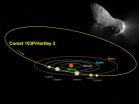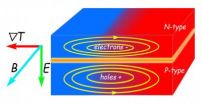(Press-News.org) On Nov. 4, 2010, NASA's EPOXI spacecraft came within 450 miles of Comet Hartley 2, a small comet not even a mile in diameter, which takes about six and a half years to orbit the sun. Designated officially as 103P/Hartley 2, the comet thus became the fifth for which scientists have collected close-up images.
But the comet was also observed from another spacecraft: the Solar and Heliospheric Observer (SOHO), better known for its observations of the sun. Together, the two returned data about what appears to be an irregular comet, belching chunks of ice and losing water at a surprisingly fast pace.
"By combining EPOXI's direct imaging with several months of SOHO data, we had a rare chance to see a comet in the process of shedding off large amounts of water," says Michael Combi, a space scientist at the University of Michigan in Ann Arbor, Mich., who wrote about his findings in a June 10, 2011 issue of the Astrophysical Journal Letters. "Comets always lose water as they heat up during the approach to the sun, but this was much more than usual. Something pretty dramatic happened in those weeks."
Understanding the composition and behavior of comets intrigues scientists because they are some of the first objects that formed around our sun some 4.5 billion years ago and they've evolved little since. These chunks of ice, rock, and frozen gas hold clues to what existed in those early days of the solar system's formation, says Combi. So he uses an instrument onboard SOHO called SWAN – for Solar Wind ANistropy – to observe how water streams off of comets.
SWAN's main job is to map the distribution of hydrogen atoms across the entire sky. This helps those who study the sun's magnetic environment by tracking how the interstellar wind of particles moves through our area of space. But the instrument also can help track comets, which are generally surrounded by an extremely thin atmosphere of water vapor. Under ultraviolet light from the sun, the hydrogen atoms fly off the water molecules at great speed and produce a huge cloud or "coma" of hydrogen. The coma absorbs sunlight and then re-emits it, making it detectable in SWAN images. Observing the clouds can then help determine how much water is being vaporized from the comet over time.
SWAN has collected data on nearly one hundred comets, so when Combi and his colleagues at Michigan learned EPOXI was destined to get a closer view of Hartley 2, they pored over old data from that comet's most recent approaches in 1997 and 2004. Unfortunately, the sun obscured SOHO's view of Hartley in 2004, but the 1997 data was accessible. They compared this to SWAN's 2010 observations from Sept. 14 to Dec. 15.
Surprisingly, the comet's water production in 1997 was three times the amount of water put out in 2010. "We've analyzed multiple comets with short periods like Hartley 2 on repeated trips around the sun," says Combi. "But none of them has shown such a drastic change from one close pass by the sun to the next."
The SWAN data captured another surprise. On Sept. 30, the hydrogen jumped by a factor of two and a half in a single day. It dropped down again some six weeks later.
Standard models of how comets behave helped Combi's team correlate the hydrogen signature to just how much of the comet's surface should be giving off water, a process known as "sublimating," because the water turns directly from ice to a vapor without passing through a liquid phase. The amount of surface area predicted didn't jibe with what EPOXI itself saw – a comet that only gave off water from one half of its shape. But EPOXI also captured images of an extended halo of icy fragments that burst off the comet, most likely flung into space by carbon dioxide emissions on the comet's surface. These ice chunks probably added sublimated water to the hydrogen cloud.
"The rate of water generation being so much higher in 1997 implies that the ice fragmentation was even more severe then," says solar physicist Joe Gurman, U.S. project scientist for SOHO at NASA's Goddard Space Flight Center in Greenbelt, Md. "To me, that means we're watching how comets eventually 'dry up' and become less active with repeated passes through the inner solar system."
Comparing EPOXI observations to SWAN's did not, however, always jibe with current understandings of comets. EPOXI measured cyanide output – an element that tends to be fairly minimal within comets but is so bright that it is easy to measure and indeed was one of the first elements identified in comets in the 1880s. Cyanide output typically correlates to water output, but in this case EPOXI saw a burst of cyanide – it increased seven times on Sept. 17 -- at a time when water production was only gently increasing.
"Analysis of all this data on Hartley 2 is just beginning," says Combi, "So it will be awhile before we figure out all that's happening. But we have here an example of an unusual comet. We don't know if this one had odd behaviors or some different kind of composition – but maybe we'll start seeing things like this, perhaps even in hindsight, in other comets."
With only five comets privy to a near spacecraft fly-by, new data points like this can help refine our understanding of comet composition. It remains an interesting scientific debate whether anomalous comets like Hartley 2 behave differently because they formed of different materials originally or because they've experienced different environments over time. As more analysis of the EPOXI and SWAN data come, the next few years should provide additional insight into these remnants from the very dawn of the solar system.
INFORMATION:
SOHO watches a comet fading away
2011-08-01
ELSE PRESS RELEASES FROM THIS DATE:
Fresh Produce Clothing's Summer-Fall Collections Feature Unique Pieces of Wearable Works of Art
2011-08-01
Fresh Produce customers can make an artful statement when they wear the eclectic prints featured in its latest collections of effortless and spirited looks. The inspired prints are available in a variety of new styles and fabrications from cool cotton voile to comfy cotton jersey and versatile rayon-lycra.
This summer's standout print is the Blue Tahitian Flower. Fresh Produce women adore this romantic watercolor-inspired motif. Its look and feel is "pure summer" with beautiful tropical flowers captured in soft, watery hues and translated to new chic tunics, ...
An unexpected clue to thermopower efficiency
2011-08-01
Scientists at the U.S. Department of Energy's Lawrence Berkeley National Laboratory (Berkeley Lab) and their colleagues have discovered a new relation among electric and magnetic fields and differences in temperature, which may lead to more efficient thermoelectric devices that convert heat into electricity or electricity into heat.
"In the search for new sources of energy, thermopower – the ability to convert temperature differences directly into electricity without wasteful intervening steps – is tremendously promising," says Junqiao Wu of Berkeley Lab's Materials ...
Boloco Earns Another 'Green' Star
2011-08-01
Back in March 2008 boloco, a chain of inspired burrito restaurants, became the first fast-casual chain in New England to become a Certified Green Restaurant by the Green Restaurant Association (GRA). But when boloco found out an even higher level of certification could be achieved - well, let's just say they reached for the stars. Boloco is now the first chain* of restaurants to become a 2 Star Certified Green Restaurant across all of their 17 locations.
For each of boloco's 17 locations to earn the GRA's rigorous two-star certification, they had to be inspected and ...
New study outlines economic and environmental benefits to reducing nitrogen pollution
2011-08-01
New, York, NY—July 28, 2011—A new study co-authored by Columbia Engineering professor Kartik Chandran and recently published in the journal, Environmental Science & Technology, shows that reducing nitrogen pollution generated by wastewater treatment plants can come with "sizable" economic benefits, as well as the expected benefits for the environment.
Chandran was one of five scientists from around the U.S. who worked on the study, along with James Wang of NOAA's Air Resources Laboratory and formerly of Environmental Defense Fund (EDF); Steve Hamburg, Chief Scientist ...
Genetic evidence clears Ben Franklin
2011-08-01
HOUSTON -- (July 28, 2011) -- The DNA evidence is in, and Ben Franklin didn't do it.
Genetic tests on more than 1,000 Chinese tallow trees from the United States and China show the famed U.S. statesman did not import the tallow trees that are overrunning thousands of acres of U.S. coastal prairie from Florida to East Texas.
"It's widely known that Franklin introduced tallow trees to the U.S. in the late 1700s," said Rice University biologist Evan Siemann, co-author the new study in this month's American Journal of Botany. "Franklin was living in London, and he had tallow ...
Scientists report dramatic carbon loss from massive Arctic wildfire
2011-08-01
In a study published in this week's issue of Nature, Marine Biological Laboratory (MBL) senior scientist Gauis Shaver and his colleagues, including lead author Michelle Mack of the University of Florida, describe the dramatic impacts of a massive Arctic wildfire on carbon releases to the atmosphere. The 2007 blaze on the North Slope of the Alaska's Brooks Mountain Range released 20 times more carbon to the atmosphere than what is annually lost from undisturbed tundra.
As wildfires increase in frequency and size along Alaska's North Slope, the team contends the disturbances ...
WSO2 Presents Workshops on Enterprise Integration and Security in the Cloud
2011-08-01
Enterprise IT architects and developers face the dual demands of optimizing their service-oriented architecture (SOA) implementations on-premise while also seeking ways to leverage the cloud. This month, WSO2 (http://wso2.com?080111w) delivers technical workshops designed to address two of enterprises' top SOA challenges: enterprise integration and security in the cloud.
Security in the Cloud: August 4, 2011, Palo Alto, CA
The WSO2 "Security in the Cloud" workshop will identify the security challenges that can stop or slow a move to the cloud, review open ...
Breakthrough lights way for RNA discoveries
2011-08-01
NEW YORK (July 28, 2011) -- The ability to tag proteins with a green fluorescent light to watch how they behave inside cells so revolutionized the understanding of protein biology that it earned the scientific teams who developed the technique Nobel Prizes in 2008. Now, researchers at Weill Cornell Medical College have developed a similar fluorescent tool that can track the mysterious workings of the various forms of cellular RNA.
In the July 29 issue of Science, the Weill Cornell investigators report how they developed an RNA mimic of green fluorescent protein (GFP) ...
Mannan oligosaccharides offer health benefits to pigs
2011-08-01
Feeding mannan oligosaccharides (MOS) can fine-tune the immune system of pigs, suggests a new University of Illinois study.
"When it comes to keeping pigs healthy, there are some potentially powerful tools we can use in the diet besides antibiotics," said James Pettigrew, U of I professor of animal science. "We have a tendency to think that we can administer health through a needle, by giving pigs antibiotics, and even through systems like all-in/all-out pig flow. These are important, but there are also many health benefits we can realize through the diet."
MOS is a ...
More illness, doctor visits reported in years after Sept. 11, UCI study finds
2011-08-01
Irvine, Calif., July 28, 2011 — The events of Sept. 11, 2001, changed the way Americans travel and view the world. They may also have made us sicker and more likely to access healthcare services, according to a new UC Irvine study.
In the first three years after the terrorist attacks, researchers found, reports of doctor-diagnosed illness climbed by 18 percent in a nationally representative sample of adults. The jump was highest in those with pre-existing health conditions, but people who were healthy before 9/11 also experienced an increase in physician-diagnosed ailments. ...




